Touring Consoles
LARGE-FORMAT DIGITAL CONSOLES
ALLEN & HEATH DLIVE S7000
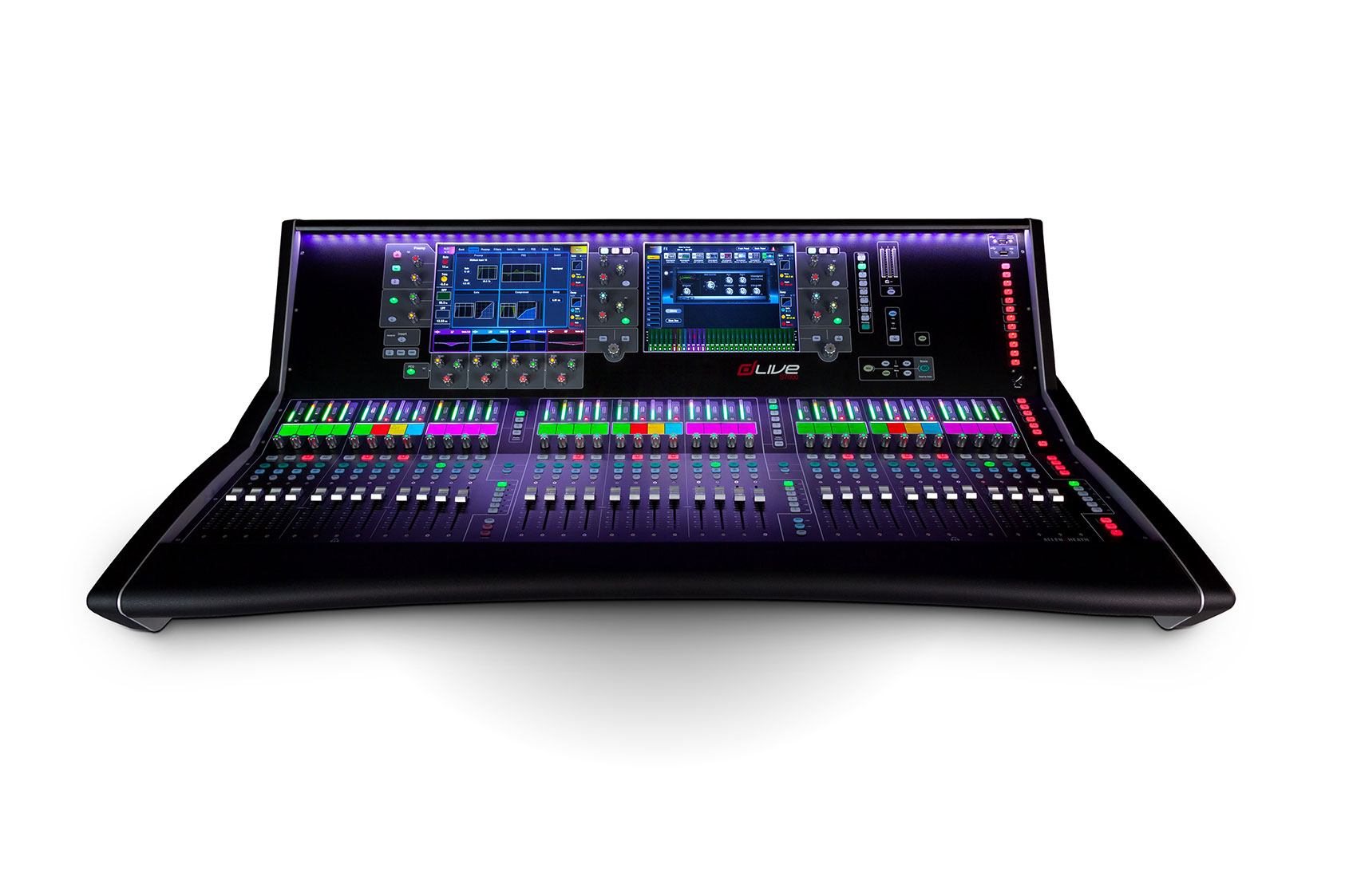
Allen & Heath’s dLive, a next generation digital mixing system, providing ultra-flexible architecture, a
powerful FPGA processing core, a comprehensive array of expansion, control and networking options, plus
the intuitive Harmony user interface with gesture control, means dLive is geared to applications from
rigorous touring and festivals to installation in prestigious live venues. The dLive Surfaces come in
a choice of three sizes – the S3000, S5000 and S7000. The S7000 is the largest control Surface in the
dLive family, with a whopping 216 assignable fader strips. It features 36 faders over 6 layers, dual 12″
capacitive touchscreens and the innovative Harmony UI for the fastest workflow in the industry.
The single or twin 12” capacitive touchscreens on the dLive consoles, respond to every pinch, swipe, drag
and drop exactly as expected. Bespoke ‘widget’ areas can also be set up on the screens to keep track of scenes,
meters, FX and other custom controls. The screen is framed by a set of one knob / one function rotary controls,
allowing the creativity and immediacy of tactile control over key processing functions, working in harmony with
the visual feedback displayed on the screen. The rotary knobs have been prototyped 20+ times to achieve optimal
grip and precision control, and feature RGB illumination, with colours mapped to functions for instant visual
orientation.
The dLive layout is fully customisable, allowing the user to create a mixing interface that matches his own mental
map of the show. Every input or mix can be assigned to any and every bank and / or layer, virtual scribble strips
allow inputs and mixes to be clearly named and colour coded for at-a-glance navigation, and the engineer has no
less than 26 assignable SoftKeys at their disposal, plus 3 pages of 6 assignable rotaries per screen.
Main Features include:
• 36 faders
• Fully assignable layout – 216 fader strips
• Harmony UI integrates screen and wrap-around controls
• 26 assignable SoftKeys
• Engineer’s Wedge and IEM fader strips
• Daylight visibility
• 8 XLR mic/line in, 8 XLR line out
• 2 digital st AES3 in, 3 digital st AES3 out
• Dual redundant, hot swappable power supply
AVID S6L
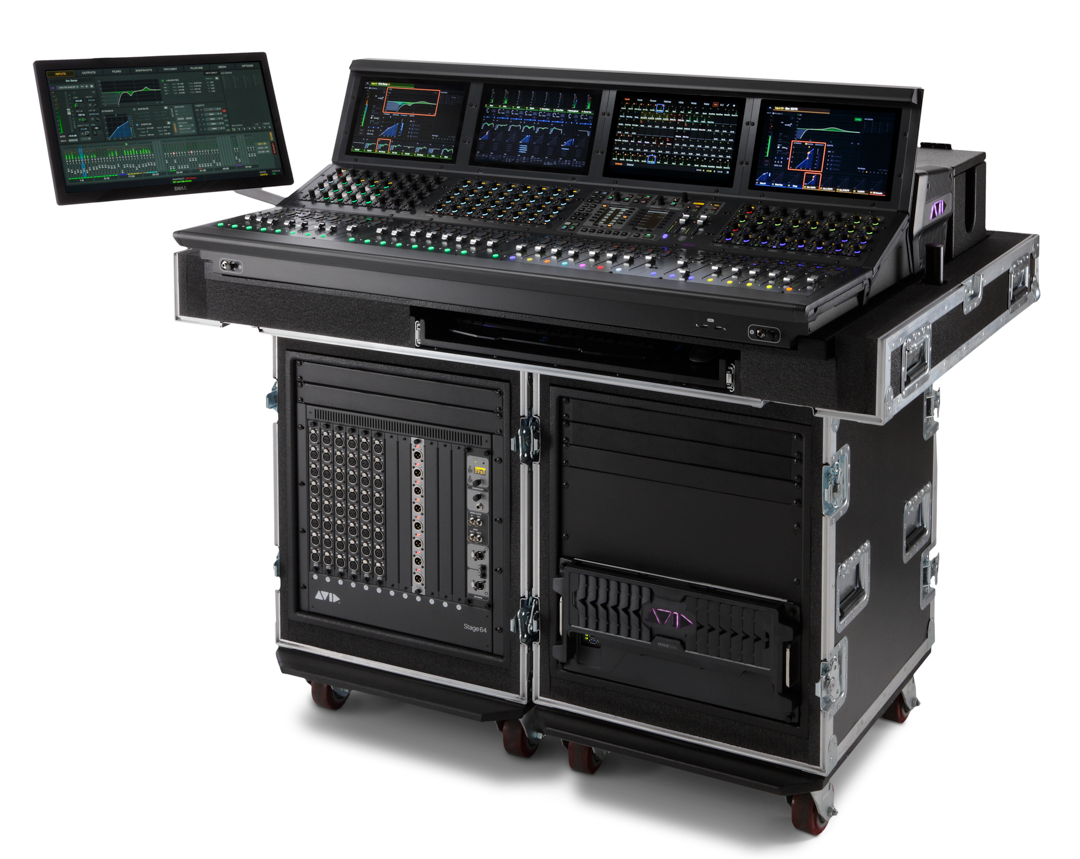
VENUE has long been one of the most popular live mixing systems in the world. And now the legacy continues with
VENUE | S6L. The new Venue S6L range features three modular consoles - S6L-32D, S6L-24D and S6L-24, with mixing
desks equipped with touch screens and network connection, a choice of two audio engines, an I/O Rack, Venue and Pro
Tools software and plug-ins for over 300 channels of processing. The S6L-32D is Avid’s largest live digital console
in the VENUE series. The S6L is available in 24-and 32-channel versions.
The modular, scalable, touchscreen-based interface, offers tight integration with the company’s Pro Tools DAW and
MediaCentral management/distribution platform is based around the E6L live sound engine, designed to handle large
channel and plug-in counts while providing low latency and 96 Hz processing.
The new system is based around a number of varied components, allowing users to build configurations that best fit
their needs.
Main Features include:
• High-resolution
• Daylight-visible touchscreens and OLED displays
• Flagship S6L-32D provides 32 + 2 faders, 96 assignable knobs, an integrated Master Touchscreen, and three integrated
Channel Touch Modules.
• S6L-24D, offers 24 + 2 faders, 64 assignable knobs, an integrated Master Touchscreen, and a pair of integrated Channel
Touch Modules.
• Finally the S6L-24 fields 24 + 2 faders, 64 assignable knobs and an integrated Master Touchscreen.
DIGICO SD10
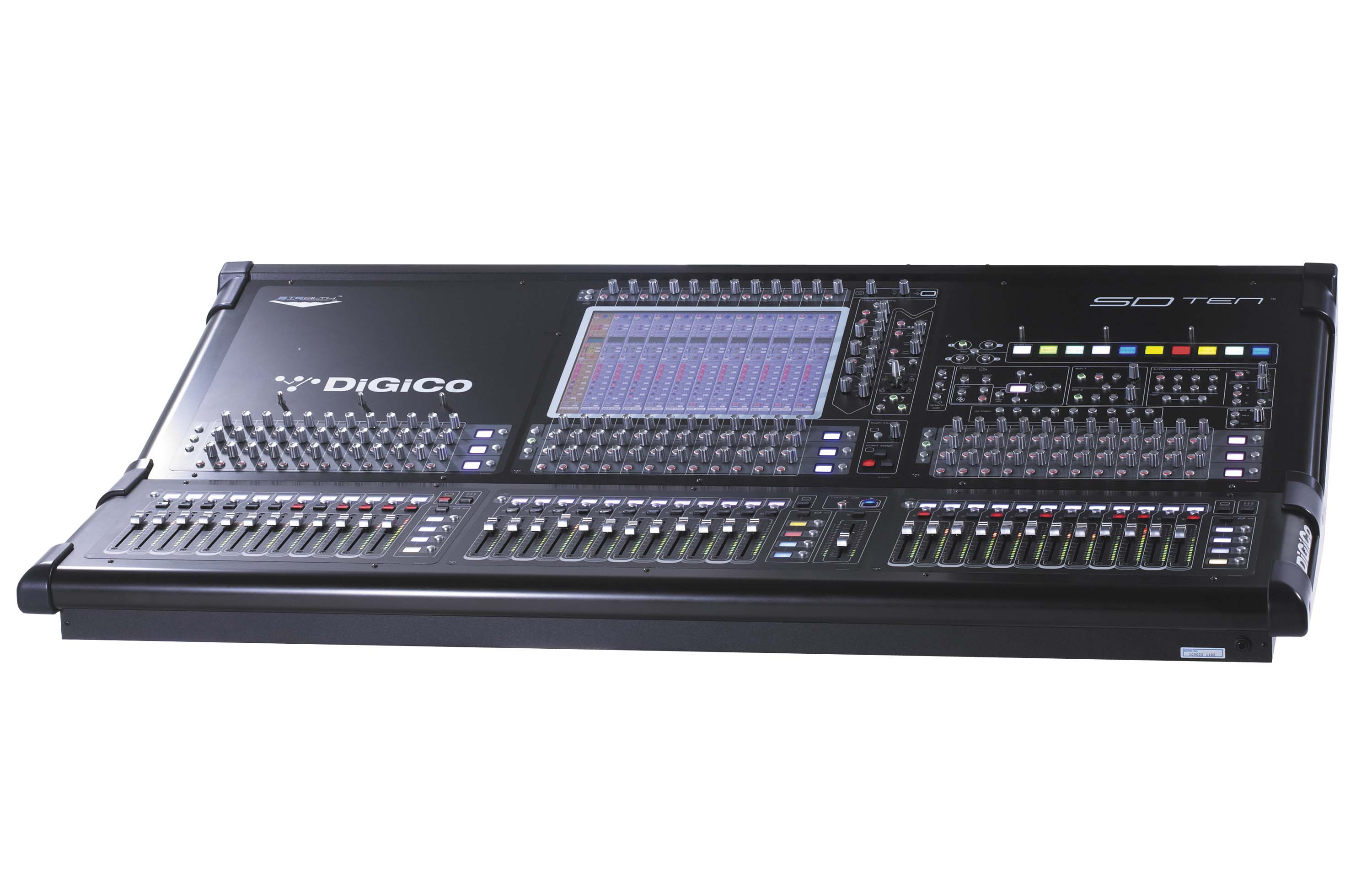
With the SD Ten, DiGiCo has pushed the boundaries of digital mixing, producing a console that boasts features
and benefits that instantly distinguish it from others in the SD Series. A large 15 inch, touch sensitive
screen provides both information and fast control of all the main parameters.
The control surface features 37 100mm touch sensitive faders, providing fast access to the console’s large
number of channels, which include 96 with full processing, 12 of which can be configured as full Flexi
Channels - and outputs that can be assigned across the surface. All inputs have dual mono inputs for
fast ‘Main’ and ‘Alt’ channel switching.
Standard output channel processing includes output delay; eight bands of parametric EQ (previously only
seen on the SD7); compressor and gate; dual insert points; groups with buss to buss routing, plus Auxes
that have direct talk to output with dim control.
Main Features include:
• Second-generation Optocore optic connections. Just like the SD7, an SD Ten can connect to up to 14 SD or D-Rack
IDs with 448 audio channels on a single redundant optical loop.
• Five redundant consoles can share all inputs from the stage racks, and out puts on the system can be assigned in
blocks of eight. For example, a single rack can provide 56 inputs to both consoles with 40 of the outputs assigned
to the monitor console and 16 used by Front of House for feeds back to the stage.
• One console can even directly route outputs to another console on the loop, for convenient tie lines.
• D-Rack, SD-Rack, SD7 and SD Ten can operate together at 96khz. The audio advantage here is clear, but also means
just over 1ms of latency when routing a stage input through a channel and buss, with processing back to a stage
output.
• Sound Grid Waves can be added, allowing full connection and control of a Waves Sound Grid, providing low latency
plugins on a floating point digital console.
• Connectivity to the outside world isn’t restricted to just the D-Rack and SD-Rack. The SD Ten comes with different
I/O options because tailored DiGiCo systems and complex set ups are completely user configurable.
CADAC CDC SEVEN
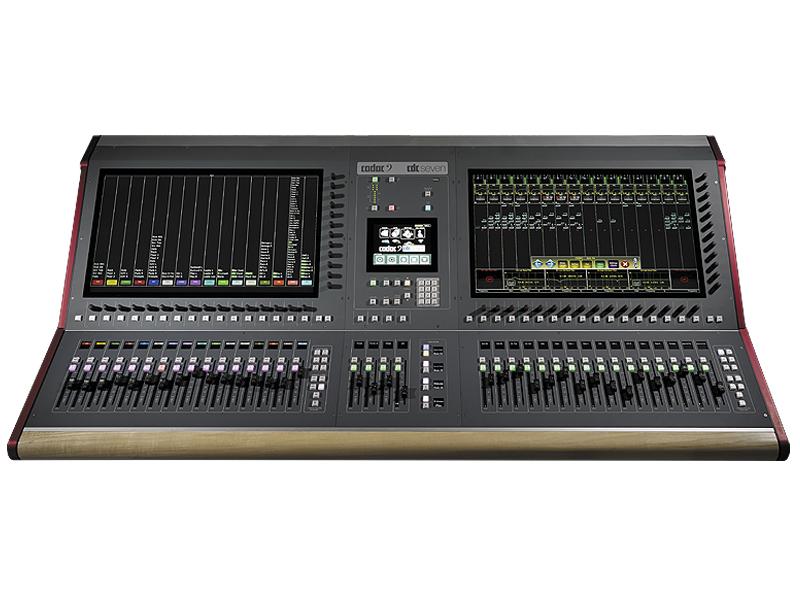
The CDC seven takes the CDC six format, Cadac’s best-selling digital console, a step further by providing dual
screens, increasing the number of faders to 36 and expanding the input count to 96. It still retains the
incredible ease of use with the minimal learning curve of the CDC six, along with its 56 busses, of which
48 are configurable, but provides the user with the luxury of an expanded physical user interface.
All 36 faders on the CDC seven feature stereo metering, with a full colour user definable OLED display above
the fader to make channel identification fool proof. Due to the impact of the latency inherent with
existing audio protocols Cadac designed its own - MegaCOMMS, a digital audio network developed to meet
the increasing performance demands of live sound.
Hardware Summary:
• Intuitive, clear graphical user interface
• Proprietary DSP mix platform
• 32/40 bit floating point SHARC processors
• Dual 23.5” flush mounted 16:9 high definition LCD touch wide screen
• 6.5” LCD touch screen for system control
• 40 user definable colour OLED displays
• 20 segment stereo channel metering
• 36 touch sensitive 100mm motorised faders
• 64 x 64 Waves SoundGrid interface
• 4 AES3 inputs and 4 AES3 outputs
• 8 fully programmable line inputs and outputs
Main features include:
• Classic Cadac mic-pres
• Sub 0.4 millisecond latency from analogue inputs on stage to analogue outputs on stage
• 96 input channels
• 56 output busses, of which 48 assignable as Group, Stereo Group, Aux, Stereo Aux or Matrix
• Unique Cadac Monitor Mode
• Custom Fader Layers
• 4 band fully parametric EQ
• Extensive dynamics
• 16 VCA groups including ‘VCA unfold’ navigation
• 16 assignable buttons with OLED displays
• 16 stereo on-board effects
• 31 band graphic equaliser on all outputs as well as 4 band fully parametric EQ
• Compressor/limiter on all outputs
• Input and output delays
• Snapshot automation system
• User definable languages for console labelling
Soundcraft Vi7000

The Vi7000 digital mixing consoles delivers the best Vi sound ever, bringing optional 96kHz processing, upgraded channel counts and even more reliable hardware to live sound’s most popular mix interface. Partnering a compact control surface with new Local Rack and Active Breakout box hardware, Vi delivers simultaneous mixing of up to 128 inputs and 32 mono/stereo busses.
Pristine sound quality is assured by ultra-low noise mic amp designs and enhanced 96kHz 40-bit floating point digital audio processing, while FX come courtesy of 8 independent Lexicon multi-FX units, BSS DPR901ii integration and a BSS graphic EQ on every bus output. Rapid configuration and powerful automation features, radio mic status monitoring and extensive ViSi Connect I/O expansion (EtherSound, CobraNet, Dante, MADI, etc.) complete the package.
Main features include:
• The latest Vistonics & FaderGlow interface
• Up to 128 inputs and 32 mono/stereo busses
• Enhanced audio processing with 96kHz sample rate option
• Powerful new features including BSS DPR901ii Dynamic EQ
• STUDER vMIX automatic microphone mixing built-in
• New Local Rack hardware for 384 I/O channels
• 128 channel record interface via MADI or Dante
• Mix live with UA plug-ins (via Realtime Rack)
Solid State Logic L500 Plus
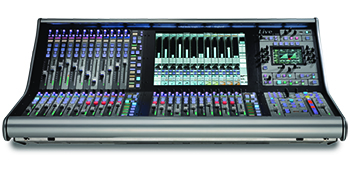
Since its introduction in 2013 the SSL Live L500 console has met widespread praise from many of the world’s
leading live engineers. L500 was designed to help highly skilled operators deliver outstanding performances in the
most demanding applications in Touring, Installation, Houses Of Worship and Theatre. Part of the success is
attributable to exemplary hardware performance throughout the signal chain: bringing SSL Studio grade mic pre’s
to the stage, outstanding audio conversion, 96kHz operation and magnificent summing.
Main Features include:
• Max Channels: 256
• Mix Engine: Tempest Optimal Core Processing
• Max Sampling Rate: 96k Hz
• Channel Faders: 36 + 2
• Onboard I/O: Up to 32 analog in / 32 out; 4 AES ins/outs.
• Remote I/O: Live I/O ML, 32 x 32 analog; Live I/O D, 32 x32 AES digital.
• Frame sizes: L300 26-fader version and 24/36-fader Remote
• Network Interfacing: MADI; Blacklight technology handles up to 256 channels
• Footprint/Weight: 47 x 35”; 200 pounds.